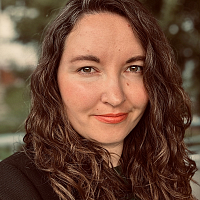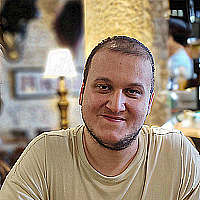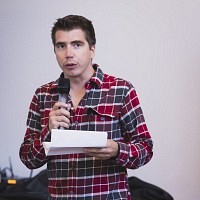- HUTLP:CLEAR
Analyst in a SOC by Day, CTI Developer by Night
 Bianka BálintBianka Bálint (Dekra, HU)
Bianka BálintBianka Bálint (Dekra, HU)
Presenting the advantages and pitfalls of different CTI integration approaches through practical examples collected during the rollout and initial phases of a CTI program. How the creation of detailed plans, assessment of stakeholders and incorporation of best practices can still lead to failure, and in which fields can a ground level CTI team triumph over more mature CTI organizations.
Bianka Bálint is a L3 SOC analyst and CTI service developer, with 10 years of experience in various cybersecurity fields. When she’s not leading incident response cases, you’ll probably find her in her vineyard or sewing something new.
April 22, 2025 14:00-14:30
- US CZTLP:CLEAR
 Keith Swagler
Keith Swagler Ondra RojcikKeith Swagler (Red Hat, US), Ondra Rojcik (Red Hat, CZ)
Ondra RojcikKeith Swagler (Red Hat, US), Ondra Rojcik (Red Hat, CZ)
Priority Intelligence Requirements (PIRs) are sometimes dismissed as "academic exercises" disconnected from practical operations. Their value is clear on a macro level to most CTI professionals. The challenge, however, lies in integrating these strategic concepts into day-to-day CTI, SOC and Security Operations, and Cyber Defense activities. When implemented effectively, PIRs not only guide CTI efforts but also strengthen the broader information security strategy by aligning it with current adversarial threats. This talk will offer a practical walkthrough of developing and operationalizing PIRs. It begins with foundational options for PIR development, followed by defining priority threat actors. It will introduce methodology for defining priority adversary TTPs from the list of priority threat actors. The process culminates in application of the priority adversary TTPs to detection, threat hunting, red teaming and updating of security controls thus ensuring threat-informed security.
Keith Swagler is a Cyber Threat Intelligence Analyst with a focus on Detection and Response at Red Hat. Keith has 10 years of IT experience, and previous security experience in Incident Response, Vulnerability Management, and Compliance.
April 22, 2025 14:30-15:00
- NLTLP:CLEAR
Build Your Own Threat Landscape (8:30-12:30)
 Gert-Jan BrugginkGert-Jan Bruggink (Venation, NL)
Gert-Jan BrugginkGert-Jan Bruggink (Venation, NL)
Bob Ross once said, “I think there’s an artist hidden at the bottom of every single one of us”. When you are ‘painting’ a company’s threat landscape, you convey answers to intelligence requirements as effectively as possible. Channel your inner artist. For example, building periodic briefings or yearly write-ups. Still, what makes a good threat landscape? What essential information should it contain?
This workshop follows a walkthrough in producing such a deliverable. Combining hands-on examples and audience interaction. Several formats will be discussed, and templates made available. In addition, special attention will be given to the machine learning and AI trends. Finally, the facilitators will share practical tips, tricks, and happy accidents after years of creating threat landscape deliverables.
After following this workshop, participants have built a first version of your team’s threat landscape deliverable or understand where you should adjust your existing deliverable. This workshop also recognizes the sensitivity of threat landscape contents.
This workshop is meant to provide cyber threat intelligence teams the canvas, paint, brushes, and techniques needed to successfully create (recurring) threat landscape deliverables. Enabling them to create a larger narrative around cyber threats to support stakeholder decision making and drive security investment.
Gert-Jan Bruggink specializes in helping leaders make informed decisions on risk to prioritise security investment. He supports teams all over the world in understanding adversary tradecraft through threat-informed security programs and providing leaders actionable threat intelligence products. Gert-Jan founded boutique firm ‘Venation’ to pioneer the field of structured threat content through cyber threat intelligence subscription and advisory services. Previously, Gert-Jan co-founded innovative start-ups, fulfilled a cyber threat intelligence leadership role at a Big Four accounting firm, and held security engineering roles at a security integrator.
April 21, 2025 08:30-10:00
- SETLP:GREEN
CTI in a PSIRT Context
 Rhys MatairaRhys Mataira (Ericsson, SE)
Rhys MatairaRhys Mataira (Ericsson, SE)
We understand well what the role of CTI is for our enterprise, but in the context of a PSIRT there are some significant challenges to establishing a CTI function when the products are not under your management or operational responsibility, and the product-related intelligence is largely kept secret.
We will take you through our findings while establishing the CTI function in our PSIRT and explain our scope and how we operationalise our intelligence.
Rhys Mataira leads major incident response activities which involve Ericsson’s product and services portfolio and brings these learnings back to the threat intelligence function for improving Ericsson’s product security posture.
April 23, 2025 09:00-09:30
- GR USTLP:CLEAR
Decoding a Decade: 10 Years of Applied CTI Discipline
 Andreas Sfakianakis
Andreas Sfakianakis Rebekah BrownAndreas Sfakianakis (ThreatIntel.EU, GR), Rebekah Brown (SANS, US)
Rebekah BrownAndreas Sfakianakis (ThreatIntel.EU, GR), Rebekah Brown (SANS, US)
Over the past decade, Cyber Threat Intelligence (CTI) has evolved from an emerging field to a foundational element within cyber defense teams. This presentation, drawing on ten years of SANS CTI survey data, provides an analysis of CTI’s evolution in response to threats, technologies, and changing organizational priorities. We will examine the distinct phases of CTI: the Foundational Years (2015-2018), marked by a focus on foundational practices and mostly reactive intelligence; the Maturing Stage (2019-2021), marked by deeper integration and the streamlining of tactical intelligence; and the Modern Era (2022-2024), which reflects CTI’s embrace of AI, geopolitics, and strategic intelligence. Attendees will gain insights about CTI’s journey, the current landscape, and emerging trends shaping its future. The main speaker and author, Andreas Sfakianakis, will not be in attendance.
Andreas Sfakianakis is a Cyber Threat Intelligence professional with over fifteen years of experience in cyber security. He focuses on applying threat intelligence and helping organizations manage threats mostly within the Energy, Technology, and Financial sectors as well as in European Union’s Agencies and Institutions. Andreas has been contributing to the CTI community since 2012 via public reports and presentations, his blog, newsletter, and instructing. His utmost goals are the maturing of threat management programs within organizations as well as the embedding CTI in policy making. Andreas Twitter handle is @asfakian and his website is threatintel.eu.
Rebekah Brown is a Senior Researcher at the University of Toronto’s Citizen Lab, working at the intersection of human rights and digital security. Her specialty is threat intelligence, analyzing everything from nation state attacks to interpersonal threats such as digital stalking and harassment. She is the co-author of the book Intelligence-Driven Incident Response and the SANS Cyber Threat Intelligence course and has been an author of the SANS CTI Survey since 2019.
April 22, 2025 09:15-09:45
- AUTLP:CLEAR
Evolve or Perish: Integrating Software Supply Chain Intel into Enterprise CTI
 Paul McCartyPaul McCarty (SourceCodeRED, AISA, AU)
Paul McCartyPaul McCarty (SourceCodeRED, AISA, AU)
This talk will explore strategies for integrating software supply chain threat intelligence into existing enterprise CTI frameworks, with a focus on the npm ecosystem as a case study. The key topics include an overview of current software supply chain threats, emphasizing package ecosystem attack trends and tactics, as well as strategies for finding and incorporating specific threat indicators from various platforms into CTI workflows.
Paul McCarty is a DevSecOps OG and has built a reputation for delivering offensive security functions for (and against!) the software supply chain. He founded SecureStack, a pioneering cloud-native software supply chain security startup in 2017. More recently, he's founded SourceCodeRED a services and training company that helps orgs address software supply chain risk. Paul has worked for NASA, Boeing, Blue Cross/Blue Shield, John Deere, the US military, GitLab and the Australian government amongst others. Paul is a frequent contributor to open source and is the author of the DevSecOps Playbook, TVPO threat modelling framework, and many other open-source projects. He’s also a pretty good snowboarder and most importantly a husband and father to 3 amazing kids.
April 23, 2025 10:00-10:30
- NOTLP:AMBER
Fortifying Your Brand: The Intersection of Cyber Threat Intelligence, Brand Abuse, and Physical Security
Alfredo Reyes (Equinor, NO)
This presentation explores the critical role of Cyber Threat Intelligence (CTI) teams in fostering internal collaboration to protect an organization's brand and contribute to physical security. Moreover, I will demonstrate how implementing a collaborative approach to threat intelligence across various organizational units creates a powerful synergy, enhancing situational awareness and preparedness against potential threats. Through real-world case studies, I'll showcase the tangible benefits of cross-team cooperation in tackling complex challenges. My primary focus will be on how multiple internal teams have joined forces to combat investment scams. I'll walk you through the process, highlighting how this collaborative effort can contribute to brand protection and employee safety. While investment scams abusing your company brand are not seen as a cyber threat, we believe it is unacceptable to remain passive in the face of crimes impacting others. By taking proactive and reactive measures, we can shield our brand, prevent potential victims from suffering financial losses and anticipate escalations by implementing crucial physical security measures.
Alfredo Reyes is a Cyber Threat Intelligence analyst at Equinor, actively involved in establishing direction and increasing collaboration across teams. His work revolves around providing Equinor with decision advantage to improve situational awareness, enabling better-informed risk-based decisions and improving cyber resilience capabilities.
April 23, 2025 09:30-10:00
- NOTLP:CLEAR
From Your Gut to a Gold Standard: Introducing the Admiralty System in CTI
 Freddy MurstadFreddy Murstad (Nordic Financial CERT, NO)
Freddy MurstadFreddy Murstad (Nordic Financial CERT, NO)
This interactive presentation introduces the Admiralty System, a framework for evaluating the reliability of information, originally used for intelligence and now adapted for modern Cyber Threat Intelligence. It explores the system's two core concepts: Source Reliability and Information Credibility, enabling participants to critically assess and rate sources and information using practical CTI examples.
Freddy Murstad is the senior advisor for cyber threat intelligence (CTI) at Nordic Finance CERT (NFCERT) and has a specific focus on strategic reporting, as well as training in structured analysis techniques (SAT) and intelligence for CTI professionals in the financial sector. Murstad is educated in intelligence from King's College London with a focus on cyber security and a master's degree in counter-terrorism from the University of St Andrews, focusing on critical infrastructure. In May 2023, Murstad started his PhD education at the Norwegian University of Science and Technology (NTNU) and will research how to implement intelligence methodology into CTI programs and how AI might change how we do intelligence analysis, and thus, how this may change how we use intelligence in CTI.
April 23, 2025 14:45-15:15
- DETLP:CLEAR
Geopolitical Cyber Threat Intelligence (14:00-18:00)
 Robin DimyanogluRobin Dimyanoglu (OC Payment GmbH, DE)
Robin DimyanogluRobin Dimyanoglu (OC Payment GmbH, DE)
Cyber operations are increasingly used as tools of statecraft, directly influenced by geopolitical events. Understanding the relationship between national policies and cyber threats is crucial for cyber threat intelligence analysts tasked with protecting organizations from state-sponsored attacks. This workshop, based on the book Geopolitical Cyber Threat Intelligence, offers CTI professionals practical approaches to analyzing how geopolitical factors shape cyber operations.
Participants will explore the intersection of cyber capabilities and national policy objectives, learning how to anticipate potential threats by analyzing global political dynamics. Through case studies of real-world conflicts such as the Russo-Ukrainian war, the Nagorno-Karabakh conflict, and tensions between Iran and Israel, attendees will gain insights into how states deploy cyber tactics in both peacetime and wartime scenarios.
Robin Dimyanoglu is a seasoned cyber security professional with over eight years of experience in Cyber Threat Intelligence, Application Security, and Red Teaming. He has worked with leading consultancy firms, delivering tailored threat intelligence and providing hands-on training in malware forensics and reverse engineering to SOC teams.
Beyond his professional work, Robin is an active member of the cyber community and frequently speaks at conferences, sharing insights from his research on Early Warning Intelligence and Predictive Cyber Defense. Drawing inspiration from war and intelligence studies, he founded Predictive Defense, where he develops and publishes novel methodologies. Robin is also the author of the book Geopolitical Cyber Threat Intelligence.
April 21, 2025 14:00-16:00
- BETLP:CLEAR
HA - Not "High Availability" but "Hunting Automation"
 Xavier MertensXavier Mertens (Xameco SRL, BE)
Xavier MertensXavier Mertens (Xameco SRL, BE)
With the amount of malware we collect daily, it's important to automate basic investigations to drop the common ones and focus on real "fresh meat". Let's see how to automate this process.
Xavier Mertens is a freelance security consultant based in Belgium. With 15+ years of experience in information security, his job focuses on protecting his customers' assets by providing services like incident handling, investigations, log management, security visualization, OSINT). Xavier is also a Senior Handler at the SANS Internet Storm Center, SANS FOR610 instructor, a security blogger and co-organizer of the BruCON security conference.
April 23, 2025 15:45-16:15
- CATLP:AMBER
Hands-On Data Breach Investigation with the Dark Net (8:30-12:30)
 Olivier Bilodeau
Olivier Bilodeau Tammy HarperOlivier Bilodeau (Flare, CA), Tammy Harper (Flare, CA)
Tammy HarperOlivier Bilodeau (Flare, CA), Tammy Harper (Flare, CA)
In this simulation, your company has just experienced a breach. You need to find sensitive data that has been leaked. This information must not fall into the wrong hands. You will need to search the dark and clear web, forums, marketplaces, ransom listings, etc. to uncover these threats. Get to the bottom of this to protect employees and avoid millions of dollars spent on damage control.
Olivier Bilodeau is a principal cybersecurity researcher at Flare. With more than 12 years of infosec experience, Olivier runs honeypots, reverse-engineers binaries, and develops RDP interception technology. He authored several important AV industry reports like Dissecting Linux/Moose, Operation Windigo (about the Ebury malware) and Ego-Market: When Greed for Fame Benefits Large-Scale Botnets. Passionate communicator, Olivier has spoken at several conferences like BlackHat USA/Europe, DefCon, 44CON, Botconf, Derbycon and more. Invested in his community, he co-organizes MontréHack — a monthly workshop focused on applied information security —, he is NorthSec’s President and runs its Hacker Jeopardy.
Tammy Harper is a Senior Threat Intelligence Researcher and Certified Dark Web Investigator at Flare. She currently is a volunteer threat intelligence researcher for the open source project RansomLook. When she is not working on infiltrating dark web communities she is listening to techno and ambient. Her other hobbies include street and nature photography, reading, camping, and learning about theoretical astrophysics, hypothetical stars, and exotic forms of matter.
April 21, 2025 08:30-10:00
- USTLP:CLEAR
If Everything is Priority... That's Okay!
 Jake NicastroJake Nicastro (Mandiant, US)
Jake NicastroJake Nicastro (Mandiant, US)
We’ve all heard it before: “If everything is priority, nothing is priority”.
We’ll challenge this statement through the lessons learned from Mandiant’s high-demand incident response work, and the Google Threat Intelligence machine that supports the frontlines. We’ll also abstract some concepts learned from time with the US military and how, believe it or not, they can translate to resource management and leading a team when “everything is priority”.
There will be some hard truths for analysts and leaders alike. But it will give confidence to challenge the notion that “if everything is priority” then maybe that’s okay!
Jake Nicastro is a Principal Intrusion Operations Analyst at Google Threat Intelligence / Mandiant. He spent 3 years as an incident response consultant before switching to intelligence, but didn't stray far. Jake's role on the Mandiant Advanced Practices team has been supporting incident response engagements with intelligence analysis and attribution. He also spent time with the US Army as an infantryman and a brief stint with cyber operations.
April 23, 2025 13:45-14:15
- NL GRTLP:CLEAR
Immaturity Can Be Fun: Just Not in a CTI Program
 Gert-Jan Bruggink
Gert-Jan Bruggink Andreas SfakianakisGert-Jan Bruggink (Venation, NL), Andreas Sfakianakis (ThreatIntel.EU , GR)
Andreas SfakianakisGert-Jan Bruggink (Venation, NL), Andreas Sfakianakis (ThreatIntel.EU , GR)
For the past decade, CTI operations in industry (and government to a lesser degree) have been driven by technology and venture capital. At the root of the problem is the misconception that because cyber threats target computers, the solution to the problem must be more technology. This misalignment has driven many corporate consumers into products and services that fail to address their needs, convincing them of value propositions they cannot fully realize. The reality is that at the root of most failed cyber-intelligence endeavors is a lack of planning and processes, further complicated by a technology-specific industry standard. While there are many CTI maturity models available, they are often tied to particular technologies or services, limiting their applicability across cyber-intelligence programs.
The CTI Capability Maturity Model (CTI-CMM) is a new practitioner-led initiative designed to break this cycle. It provides a comprehensive, flexible framework that can be applied across industries, independent of specific technologies. This talk explores how this vendor-neutral initiative offers a clear and practical approach to assessing the maturity of cyber-intelligence programs. In particular, we’ll address how the CTI-CMM:
- Offers unique value that compliments other models.
- Enables teams to broaden their operational scope (potentially securing greater funding).
- Deepens enterprise-wide engagement and appreciation for CTI.
- Can be used to develop a practical roadmap for maturing your program.
These benefits enable organizations to create a more resilient and adaptive cyber-intelligence program that aligns better to their strategic objectives. We invite practitioners to contribute to this critical, community-driven initiative.
Gert-Jan Bruggink specializes in helping leaders use proven systems to make informed decisions about digital risk. He supports teams all across the world in understanding adversary tradecraft through narratives and systems thinking. Providing understanding of their threat landscape, enabling informed decision-making and developing cost-effective risk mitigation strategies. Gert-Jan is Founder & CEO of ‘Venation’, where he pioneers the field of scenario-based cyber threat intelligence deliverables. Previously, Gert-Jan co-founded innovative start-ups, fulfilled a cyber threat intelligence leadership role at a Big Four accounting firm, and held security engineering roles at a security integrator.
Andreas Sfakianakis is a Cyber Threat Intelligence professional with over fifteen years of experience in cyber security. He focuses on applying threat intelligence and helping organizations manage threats mostly within the Energy, Technology, and Financial sectors as well as in European Union’s Agencies and Institutions. Andreas has been contributing to the CTI community since 2012 via public reports and presentations, his blog, newsletter, and instructing. His utmost goals are the maturing of threat management programs within organizations as well as the embedding CTI in policy making. Andreas Twitter handle is @asfakian and his website is threatintel.eu.
April 22, 2025 09:45-10:15
- LUTLP:CLEAR
 Sami MokaddemSami Mokaddem (CIRCL, LU)
Sami MokaddemSami Mokaddem (CIRCL, LU)
This session will walk you through how easy and powerful it can be to integrate new tools into your existing cybersecurity workflows in MISP. You'll learn the practical steps of plugging in external tools using misp-modules and misp-workflows, see a live demo of the process, discuss common integration challenges, and understand how automation with MISP can significantly reduce time to respond to threats and improve efficiency.
Sami Mokaddem is a software developer who has been contributing to the open-source community since 2016 in the fields of information sharing and leak detection. He is working for CIRCL and is part of the MISP core team where he develops and maintains the software as well as its related tools.
April 21, 2025 14:00-16:00
- US GB NOTLP:GREEN
Intelligence Collection Planning Workshop: How to Create A Plan that Synchronizes Collection with Your Stakeholders' Needs (8:30-12:30)
 Garrett Carstens
Garrett Carstens Kevin Williams
Kevin Williams Freddy MurstadGarrett Carstens (Intel471, US), Kevin Williams (Intel471, GB), Freddy Murstad (Nordic Financial CERT, NO)
Freddy MurstadGarrett Carstens (Intel471, US), Kevin Williams (Intel471, GB), Freddy Murstad (Nordic Financial CERT, NO)
Join industry leaders for an engaging half-day workshop that introduces the core fundamentals of building an intelligence collection plan that aligns to stakeholder needs - individually and at scale - and creates a foundation for measuring success of your CTI program.
Participants will gain hands-on experience building their own plan from scratch using a scenario-based practical exercise, non-proprietary tools, and a catalog of "take home" resources including training videos, fillable templates and worksheets that are provided free of charge for use in their own environments.
Garrett Carstens is the Vice President of Intel Operations at Intel 471 coordinates internal and cross-departmental initiatives focused on optimizing timely and relevant intelligence production and delivery. Prior to joining Intel 471, Garrett spent over 15 years in various roles within the U.S. Department of Defense and the financial sector– always with a primary mission of identifying, analyzing and mitigating cyber threats.
Kevin Williams has held senior roles at the Metropolitan Police Service, the UK’s National Crime Agency, KPMG UK, Pluralsight, and Intel 471, where he focused on intelligence gathering, threat analysis, and stakeholder engagement. During his 25 years with law enforcement, he was instrumental in developing and implementing national cybercrime strategies, including advising the UK government on the cyber incident response for the London 2012 Olympics.
Freddy Murstad is currently doing his PhD on the cross-section of intelligence and Cyber Threat Intelligence (CTI) and will research how the intelligence field can help mature the CTI field in the private sector. While researching for his PhD, Freddy also works as the senior threat intelligence analyst at Nordic Financial CERT (NFCERT) in Norway where he supports the financial sector with strategic intelligence. Freddy uses his education and experience with intelligence to bring a multifaceted approach to CTI and provide value to stakeholders.
April 21, 2025 08:30-10:00
- CA GB LTTLP:CLEAR
Leveraging Geopolitical Intelligence in the Private Sector: Key Findings from a Multi-Industry Study
 Brian Hein
Brian Hein David Hunt
David Hunt Lukas VaivuckasBrian Hein (Silobreaker, CA), David Hunt (Silobreaker, GB), Lukas Vaivuckas (Silobreaker, LT)
Lukas VaivuckasBrian Hein (Silobreaker, CA), David Hunt (Silobreaker, GB), Lukas Vaivuckas (Silobreaker, LT)
As geopolitical and cyber risks continue to rise, intelligence teams need to better understand, anticipate and respond to global crises and the impact on their business.
In this talk, we will present the qualitative findings from a multi-industry study that examines the operational application of intelligence to geopolitical risks.
Brian Hein lives and breathes collaboration and threat Intelligence. A German living in Canada's Capital Ottawa (via Laguna Beach, California) who has spent years conducting advanced threat research at HP's Office of the CTO and HP Security Research as well as at Flashpoint Intelligence. Brian also explored cyber threat intelligence at DTAG, one of the world’s largest carriers. After a year supporting Canadian initiatives, he joined Silobreaker, who supported Brian’s mission for over a decade. Brian has co-authored several books and helped develop a couple of patents.
David Hunt is a Senior Product Manager at Silobreaker. His expertise covers a wide range of risk domains, including corporate risk, corporate security, insurance, and national security. He has successfully developed and implemented solutions for geopolitical, operational, supply chain, cyber and ESG risks. His background includes significant roles at S&P Global, IHS Markit, and Exclusive Analysis, where he led teams in applied analytics, product development, and risk forecasting. David holds an MA in International Conflict Analysis and a BA in War Studies from King's College London.
Lukas Vaivuckas has been with Silobreaker for 4 years, initially as an analyst and currently as a solutions consultant. Lukas works with clients in the US, Europe, Australia and Japan to implement intelligence collection and analysis workflows. Before pivoting to security technology, his expertise was focussed on threat assessments in the defence contracting space. Lukas holds an MSc in International History from LSE, and a BA in War Studies and Philosophy from King’s College London.
April 22, 2025 11:45-12:15
- DETLP:CLEAR
Navigating the Fog of War: A Programmatic Approach to Capturing and Communicating Relevant Insights from Rising Geopolitical Tensions
 Simone KrausSimone Kraus (indevis GmbH , DE)
Simone KrausSimone Kraus (indevis GmbH , DE)
This talk seeks to use the Russia-Ukraine war as a case study on how CTI teams can determine relevance and assess impact potential throughout rising geopolitical tensions, delving into third and fourth order effects. The talk will examine threat actor dynamics, ranging from targeting decision calculus to capabilities and frequency employed to how baseline understanding is apt to shift from a preconceived understanding of normal MO. It will discuss the potential for an emergence of new cyber threat actors to appear that were not previously tracked like GRU Unit 29155 operators.
Attendees will be pressed to reconsider their assumptions around appropriate messaging, cadence, and workflows relating to relevant threat actors baselines.
The talk concludes by challenging the audience to think about how a China-Taiwan conflict may impact its organizations, similarities in approach, and how this type of geopolitical event varies from what transpired during the Russia-Ukraine conflict, acknowledging China's more prominent global influence and blowback potential to most organizations.
Simone Kraus, a seasoned IT-security professional, has been navigating the industry since 2001. After completing her apprenticeship, she pursued computer science studies and specialized as an SAP consultant. In 2013, she briefly left IT to explore diverse roles, including as a triathlete, fitness coach, and “Civilian on the Battlefield” (COB) for the US Army and Bundeswehr. Her passion for IT security eventually led her back, beginning as a DFIR Consultant and later transitioning to a Security Analyst role in 2022. Today, Simone holds the position of Senior IT-Security Specialist SOC where she focuses on threat intelligence, detection engineering and threat hunting.
April 22, 2025 11:15-11:45
- USTLP:CLEAR
Numbers Game: The Case for Quantifying Cyber Threats
 Scott SmallScott Small (Tidal Cyber, US)
Scott SmallScott Small (Tidal Cyber, US)
Most CTI practitioners agree that threat prioritization is essential, but consensus hardly exists on how to prioritize something as complex as one APT group or ransomware operation over another. This session outlines why, after a decade supporting & consulting 100+ intelligence teams, the speaker firmly believes that quantification is the solution for more consistent & less biased threat prioritization, highlighting a tangible, successful case study from the physical security space (an ongoing U.S. government cargo security program launched in 2001). Then, we will dive into a review of numerous public data sources that can yield value for threat quantification, and a simplified methodology for using that data to generate rank-ordered lists of priority threats.
Scott Small is a security & intelligence practitioner and expert in cyber threat intelligence & threat modeling, open source research & investigations, and data analysis & automation. He currently serves as Director of Cyber Threat Intelligence at Tidal Cyber. Scott has advised enterprise and public sector security teams across maturity levels on technical and strategic applications of intelligence and on using technology to help identify and mitigate organizational risk. Throughout his career, he has briefed and trained large and small audiences and has presented original content at major security conferences, including DEFCON, FIRSTCON, MITRE ATT&CKcon, & BSides, and ISAC & other industry events.
Scott is an active member of the professional security and intelligence communities and a proponent of open-source information for upskilling and strengthening our collective security. In addition to contributing to community projects, he has published independent projects that aggregate and streamline publicly accessible security resources, as well as his own original tools & resources.
April 22, 2025 10:45-11:15
- DETLP:CLEAR
Operationalization of Sigma Rules
 Thomas PatzkeThomas Patzke (Evonik Industries AG, DE)
Thomas PatzkeThomas Patzke (Evonik Industries AG, DE)
Log events appear differently in SIEMs. There are plenty of different taxonomies, possibilities for customization or just migration scenarios that make it challenging to generate queries from Sigma rules that match on events in given log repositories. Processing pipelines are a feature of the open-source Sigma toolchain that offer a solution for these challenges and this workshop shows some real-world use cases for them.
For this workshop, Thomas has released a GitHub repository containing some instructions for installation of the prerequisites that participants need for doing the hands-on exercises.
Thomas has 18 years' experience in information security and has done lots of stuff in this area, from offensive to defensive security topics. Now he is doing incident response, threat hunting and threat intelligence at the Evonik Cyber Defense Team. Furthermore, he is co-founder of the Sigma project and maintains the open-source toolchain (pySigma/Sigma CLI).
April 21, 2025 14:00-16:00
- AUTLP:GREEN
Ransomware Payment Profiles - Exposing the Risk through Enhanced STIX Threat Intelligence
 Adam TurnerAdam Turner (Google Cloud; Macquarie University; Social Cyber Institute, AU)
Adam TurnerAdam Turner (Google Cloud; Macquarie University; Social Cyber Institute, AU)
The ransomware attacker can be seen pursuing a dual modus operandi. Using the malware attack as a tool of destruction whilst pursuing a financial motivation to profit from the proceeds of cybercrime to fund further nefarious activities. This research proposes a methodology for risk profiling ransomware payment networks for threat intel researchers by using open source data and the STIX format. It aims to provide a common standard for following a ransomware attacker and its victims into the crypto-payment ecosystem and giving investigators the means to conduct ransomware payment profiling and sharing such intel across platforms.
Adam Turner holds a PhD in Security Studies and Criminology from Macquarie University (Australia) where his research investigated the payment networks of ransomware attacks. He currently works at Google Cloud where he consults to large enterprise customers on their cloud computing needs. He continues his research focus as a Senior Industry Fellow at the Social Cyber Institute and as a member of the RMIT Industry Advisory Board for Cyber (IABC) where he explores the human, organization and technology impacts affecting cyber security in society and enterprises. In particular the payment behavior of ransomware attacks and how this data can be utilized for security and policy researchers.
April 23, 2025 15:15-15:45
- AUTLP:CLEAR
Rethinking Data Visualisation for CTI
 Chris HorsleyChris Horsley (Cosive, AU)
Chris HorsleyChris Horsley (Cosive, AU)
We deal with a lot of data and information in CTI that demands visualisation to improve understanding. We often reach for common and convenient visualisations at hand like graphs and maps but we can do better. It may not be as hard as you think!
We'll talk about:
- why we visualise things in the first place
- what makes a data visualisation useful
- visualisation principles
- shortcomings of some popular visualisation types
- some visualisation types you may not have encountered before
- great visualisations for CTI in particular
- shortcuts to making your own custom visualisations
Chris Horsley is the CTO and one of the co-founders of Cosive, a cybersecurity and CTI specialist consultancy based in Australia and New Zealand. He has worked on projects with financial institutions, government, resource companies, and the university sector with a particular focus on SOCs, IR, and CTI practices and tooling. He is also highly involved in Cosive’s tooling and service offerings such as its managed MISP service and threat intelligence platform integrations. He also enjoys experimenting with CTI data formats like STIX and MISP and how to visualize and represent CTI concepts better.
He also has a long background in the international CSIRT community, which spanned roles including open-source intelligence gathering, vulnerability disclosure handling, software and tooling development, malware analysis, and joint initiatives for national CSIRTs. Chris has previously worked as a security analyst for AusCERT, the national CSIRT at that time, and JPCERT/CC, the Japanese national CSIRT.
April 22, 2025 16:00-16:30
- FR LUTLP:CLEAR
Scoring Vulnerabilities by Leveraging Activity Data from the Fediverse
 Cédric Bonhomme
Cédric Bonhomme Alexandre DulaunoyCédric Bonhomme (CIRCL, FR), Alexandre Dulaunoy (CIRCL, LU)
Alexandre DulaunoyCédric Bonhomme (CIRCL, FR), Alexandre Dulaunoy (CIRCL, LU)
We have observed that vulnerabilities, proof-of-concepts (PoCs), and remediation strategies are frequently discussed online before they are officially published—sometimes from just a few hours to several weeks in advance.
Twitter’s restriction on free API access has impacted many communities that relied on its data. Meanwhile, Twitter is increasingly being abandoned in favor of Mastodon, especially within the infosec community. Consequently a new category of social network is emerging, more decentralized and more challenging to monitor. Of course, our work is not limited to social networks.
Monitoring information and discussions related to vulnerabilities across the web is essential. We believe that enriching vulnerability information before its public release can be highly beneficial for analysts. When people actively seek or exchange information about a vulnerability, it signals that the issue should be prioritized.
Cédric Bonhomme is a seasoned computer scientist with a deep passion for computer security and privacy. From 2010 to 2017, he worked as an R&D Engineer at a research center, specializing in Multi-Agent Systems and Cybersecurity. Since 2017, he has been an integral part of CIRCL, actively contributing to CSIRT operations and the development of innovative open-source software projects. Currently, he serves as the lead developer of Vulnerability-Lookup, driving advancements in vulnerability research and management.
Alexandre Dulaunoy encountered his first computer in the eighties, and he disassembled it to know how the thing works. While pursuing his logical path towards information security and free software, he worked as senior security network consultant at different places (e.g. Ubizen, now Cybertrust). He co-founded a startup called Conostix, which specialised in information security management. For the past 6 years, he was the manager of global information security at SES, a leading international satellite operator. He is now working at CIRCL in the research and operational fields. He is also a lecturer in information security at Paul-Verlaine University in Metz and the University of Luxembourg. He is also the lead developer of various open source tools including cve-search and member of the MISP core team. Besides his activities in cyber-security, he's also fond of generally fixing anything that's broken around the office.
April 22, 2025 15:30-16:00
- DKTLP:AMBER
Securing Green Energy: CTI, OT, and Geopolitics
 Ilmar ÜleIlmar Üle (Ørsted, DK)
Ilmar ÜleIlmar Üle (Ørsted, DK)
Ørsted is a green energy company, operating assets in Europe, US, and the Asia-Pacific. Working at the world’s largest operator of offshore wind farms, our CTI team is faced with unique challenges of producing and delivering cyber threat intelligence to a global and diverse collection of systems and networks. Equally important is integrating cyber threat intelligence with geopolitical background information, as geopolitical causes can have cyber effects for critical service providers in the energy industry.
Ilmar Üle is a lead cyber threat intelligence analyst at Ørsted. He started his career as an incident responder and computer forensics analyst in 2003, transitioning into CTI in 2014. Ilmar’s previous employers include the Estonian Ministry of Defence, NATO, and CERT-EU.
April 22, 2025 13:30-14:00
- LUTLP:CLEAR
 Alexandre DulaunoyAlexandre Dulaunoy (CIRCL, LU)
Alexandre DulaunoyAlexandre Dulaunoy (CIRCL, LU)
At CIRCL, we have observed continuous activity over the past years in the field of threat intelligence, focused on gathering new pivot points, particularly from threat actors attempting to conceal their activities. In this talk, we will present various strategies for uncovering more insights by creating new pivot points in threat intelligence, ranging from analyzing common favicons to tracking QR codes and barcodes exchanged by cybercriminals.
We will also demonstrate how to use the tools to automatically create pivot points and uncover the relationships between threat actors.
Alexandre Dulaunoy encountered his first computer in the eighties, and he disassembled it to know how the thing works. While pursuing his logical path towards information security and free software, he worked as senior security network consultant at different places (e.g. Ubizen, now Cybertrust). He co-founded a startup called Conostix, which specialized in information security management. For the past 6 years, he was the manager of global information security at SES, a leading international satellite operator. He is now working at CIRCL in the research and operational fields. He is also a lecturer in information security at Paul-Verlaine University in Metz and the University of Luxembourg. He is also the lead developer of various open-source tools including cve-search and member of the MISP core team. Besides his activities in cyber-security, he's also fond of generally fixing anything that's broken around the office.
April 23, 2025 11:00-11:30
- ESTLP:CLEAR
Turning Setbacks into Strengths: Real-World Lessons in Cyber Threat Intelligence
 Tunahan DabakTunahan Dabak (SOCRadar, ES)
Tunahan DabakTunahan Dabak (SOCRadar, ES)
In this engaging session, SOC Radar CISO Ensar Seker will explore the unpredictable journey of Cyber Threat Intelligence (CTI) by highlighting real-world cases of both setbacks and breakthroughs. Attendees will gain a deeper understanding of how failed initiatives—whether due to process misalignment, poor data utilization, or communication breakdowns—can be transformed into lessons that drive lasting success. Through practical examples and strategic insights, this talk will equip security leaders and professionals with the knowledge to turn CTI challenges into opportunities for innovation, improved threat response, and organizational resilience.
April 23, 2025 13:15-13:45
- DE
 Prof. Dr. Thomas SchreckProf. Dr. Thomas Schreck (Munich University of Applied Sciences, DE)
Prof. Dr. Thomas SchreckProf. Dr. Thomas Schreck (Munich University of Applied Sciences, DE)
Dr. Thomas Schreck is a Professor for IT-Security at the Munich University of Applied Sciences. Prior he was a Principal Engineer for IT-Security at Siemens and the Head of Siemens CERT. He served between 2015 and 2021 on the Board of Directors of FIRST.org and was the Chairman from 2017 to 2019.
April 22, 2025 09:00-09:15
- IETLP:AMBER
You Shall Not Pass! (Without Proper Attribution): Untangling a Complex Attribution Case
 Asli KoksalAsli Koksal (Google, IE)
Asli KoksalAsli Koksal (Google, IE)
In the complex landscape of cyber threat investigations, misattribution of even a single event can have cascading effects, leading to incorrect conclusions about threat actors and their motivations. This talk delves into real-world cases where a misattributed event entangled investigations into unrelated cybercrime and espionage activities.
Asli Koksal (Google, IE)
Asli Koksal is a Senior Researcher in Google Threat Intelligence Group with in-depth knowledge of tracking and hunting of Middle Eastern state-sponsored actors.
April 23, 2025 11:30-12:00































